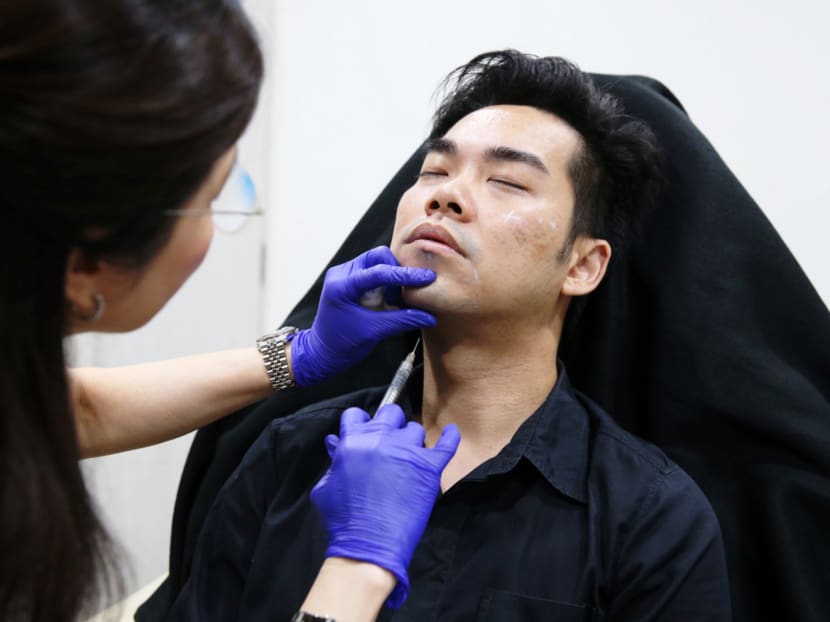More men getting facelifts to advance in their careers
SINGAPORE — To get ahead in the rat race and give their careers a boost, more men are turning to aesthetic and cosmetic treatments to obtain an “alpha male look”, some doctors say.


SINGAPORE — To get ahead in the rat race and give their careers a boost, more men are turning to aesthetic and cosmetic treatments to obtain an “alpha male look”, some doctors say.
Men now form about a fifth of Ageless Medical Centre’s clientele, a proportion that has doubled over the last five years. Fifteen per cent of the patients at See Aesthetics and Medical Clinic are male, while plastic surgeon Martin Huang has noted a 5 to 10 per cent increase in male patients, who currently make up about a quarter of his customers.
Popular procedures include fillers for a more defined nose and jawline, liposuction to fix a double chin, and botulinum toxin and collagen injections to fill out wrinkles.
LOOKS DO MATTER
Doctors said their patients do it to enhance their looks as well as give their ego and confidence a boost.
“The reasons men decide to have something done (to their faces) are similar to why women do them — such as to improve self-image and boost self-confidence,” said Dr Huang, director of MH Plastic Surgery.
“However, men probably feel more pressure than women to look their best in the workplace, especially as they get older and start worrying about job competition from younger and better-looking men.”
This is particularly true for those working in the marketing, sales, banking and finance industries, who regularly meet people in their line of work, and in which first impressions count, said Ageless Medical Centre medical director Lam Bee Lan.
“Looking youthful plays a part in looking like an ‘alpha male’ at work; it’s about looking like you are approaching your prime, not past your prime,” she added.
Social media and increasingly open attitudes towards aesthetic treatments also play a part in the rise of the male aesthetics trend here.
“Those under 40 are more conscious of their appearance and receptive to seeking aesthetic treatments. These men grew up in an era where social taboos defining what ‘correct’ male behaviour is are losing their influence,” said Dr Joseph See of See Aesthetics.
Film-maker Lincoln Chia, 35, is someone who has made aesthetic treatments a routine part of his personal grooming regimen.
Ten years ago, he paid S$700 for his first aesthetic procedure — a filler treatment to achieve a more defined nose bridge.
“That year, my film was selected for a screening at a film festival in Hong Kong. I was also invited to be part of a panel discussion after the screening and I wanted to look my best,” he said.
And he has undergone more procedures since, the latest being a S$6,600 mixed bag of treatments to enhance his cheeks, cheekbones, jawline and chin.
He also had work done to correct his tear trough to reduce the sunken and tired look of his under-eye area.
For others, such as 57-year-old John Battersby, aesthetic procedures such as fillers are a “morale booster”. He has done work on his cheeks, around the mouth and tear troughs to reduce under-eye dark circles.
“In my line of work, I am surrounded by people 10, 20 and even 30 years younger than I am, so I feel a certain pressure to look good, especially when meeting potential clients,” said Mr Battersby, who works in marketing.
His wife, who is 18 years younger than him, was the person who first suggested that he undergo aesthetic treatments, joking that people might mistake him for her father if he did not look after himself.
Numerous studies suggest that looks do matter in the workplace. For instance, good-looking job candidates are more likely to get hired compared to peers deemed less attractive, according to a 2009 study published in the Swiss Journal of Psychology.
And the benefits go on. For every additional unit of attractiveness that over 700 masters of business administration graduates get on a five-point scale, the men and women earn an average of US$2,600 (S$3,633) and US$2,150 more, respectively, over their peers on an annual basis, a study published in the Journal of Applied Social Psychology in 2006 revealed.
LOOKING LIKE AN ALPHA MALE
Experts say the most popular treatments favoured by men in Singapore are those which play up the “alpha male” look of strong, defined facial features.
Compared to Caucasian men, Asian men generally have less prominent facial features, such as wider and more rounded faces, higher eyebrows, lower nose bridges, more receded chins and less angular jawlines, said Dr See.
“The type of enhancements (men) typically ask for amount to the same thing: A stronger chin and jawline, and a more defined nose — those are what give the man a more masculine look,” said Dr Huang.
The procedures offered include hyaluronic acid (HA) fillers, which can give the look of a stronger nose. Excess fat from a double chin can also be surgically removed via advanced liposuction techniques or a non-invasive method using a fat-freezing technique for a stronger, more defined chin.
Doctors said these procedures are similar to the ones women undertake, just that given the anatomical differences, the treatment is carried out differently.
For example, Dr See said injecting fillers in the upper outer cheeks may look “aesthetically pleasing” on women, but it would make men look effeminate.
To give saggy skin — a tell-tale sign of ageing — a lift, suspension threads made of biodegradable sutures and bio-stimulating fillers may be used to stimulate the body’s collagen production, said Dr Lam.
Botulinum toxin injections are also frequently used to relax wrinkle-causing muscles to give the face a more refreshed and youthful look.
But not everyone wants to totally erase their crow’s feet or smile lines, said Dr Lam. For the corporate high-flying types in their 40s or older, ‘‘these features suggest experience, which is important at work, and when negotiating with clients, partners or employers”, she added.
As a work investment, these treatments do not come cheap. Many, particularly the non-permanent aesthetic procedures, will require regular top-ups.
For example, depending on the brand of the HA fillers used and the treatment site, their effectiveness can last between six months and two years, said Dr See. Filler prices can range from S$800 to S$1,200 per syringe, he added.
Bio-stimulating fillers, commonly used to treat volume loss in areas such as the forehead and mid-face, are priced from S$1,200 onwards, while suspension threads may cost from S$1,800 onwards, said Dr Lam.
Regardless, men such as Mr Battersby believe looking good is a necessary investment. Just as he watches his diet and goes to the gym regularly to keep his body toned, he intends to continue with aesthetic treatments to keep his face “in shape”.
“It’s like putting on a good suit and freshly polished shoes for an important meeting,” he said.






